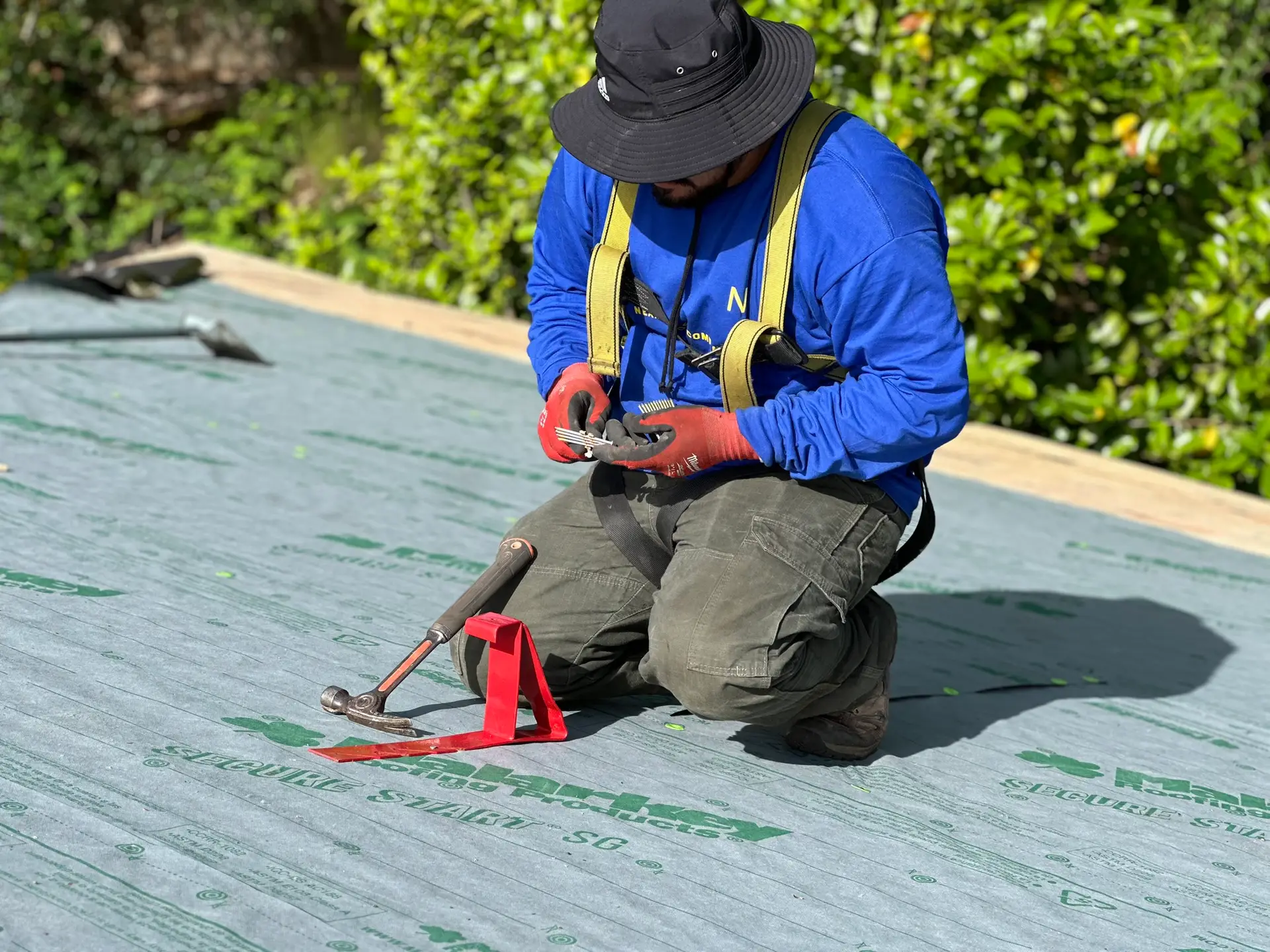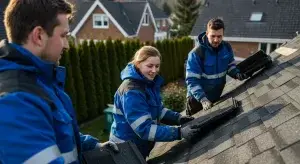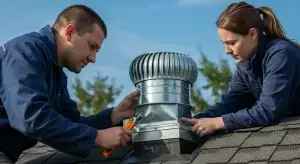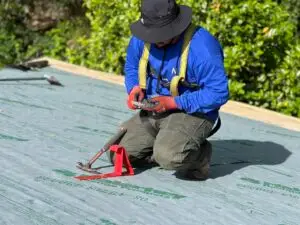As a homeowner in Seattle and the Greater Puget Sound area, you need to pay attention to what your roof is trying to say otherwise you might have to face costly repairs, structural damage, and even health hazards like mold.
In Washington, where annual rainfall can average 37 inches in the Greater Puget Sound area, your roof faces challenges that are quite different from those in drier climates. While the average roof should last 20-30 years (variations being because of the material used), roofs in wet climates have much shorter lifespans, especially if they’re not regularly maintained.
Understanding when to replace your roof can save you thousands of dollars in energy costs and potential structural damage. But how do you know when it’s time to change your roof? Here are five signs to watch out for.
1. Old Roof (Usually More Than 20 Years Old)
In the Pacific Northwest (PNW), roofs bear the brunt of constant exposure to moisture, temperature fluctuations, heavy moss, and algae growth, and wind-driven rains that speed up wear and tear – even if the roof looks intact on the outside.
If your roof is more than 20 years old, it may be time to schedule a free roof inspection. A general rule of thumb is that once your roof reaches 75% of its expected lifespan, start getting annual inspections so that you can avoid emergencies and budget for any repairs or replacements that might be needed.
Different materials age differently, and the climate of the region you live in can also impact the lifespan of your roof. Here’s an easy breakdown of the lifespan of the most common roof types:
| Roofing Material | Average Lifespan (General) | Lifespan in PNW Climate | Signs of Aging |
| Asphalt Shingles | 20-30 years | 15-20 years | Curling edges, loss of granules |
| Wood Shingles/Shakes | 30-40 years | 20-30 years | Splitting, moss/algae growth, rot |
| Metal Roofing | 50-70 years | 40-60 years | Rust spots, loose panels, fading |
| Tile Roofing | 75-100 years | 60-85 years | Cracking, broken tiles, flaking glaze |
Here are some short-term solutions you could use to reinforce your roof while you prepare for more extensive work:
- Apply professional-grade sealant for areas with minor wear
- Strategically repair individual shingles that are damaged
- Reinforce weak spots with added support in the attic
Note that these temporary fixes are just that – temporary fixes. All they do is buy you some time before you fix your roof.
2. Leakage and Water Damage
Do you see yellow or brown water marks on your ceiling or walls – especially after rain? Is the paint peeling off on the upper floors? Have you noticed musty mold or mildew smells around the house? If your answer is yes to any of these questions, your roof may be leaking.
Unchecked leaks lead to water damage such as rotting wood, mold, and even structural damage. They’re commonly caused by:
- Cracked flashing around vents and chimneys
- Water pooling on roofs that are flat or have less sloping
- Worn-out shingle underlayment
Poor ventilation also traps moisture and heat, weakening roofing materials. And while they may start off as small problems, leaks can quickly escalate into major structural issues.
Even though water damage is something all homeowners should watch out for, Seattle homeowners and those in the surrounding areas should be even more alert because of the damp local climate.
Trim trees surrounding your roof to allow sunlight to reach which will prevent water and moisture from gathering. Create a roof monitoring schedule that’s in line with the local weather and schedule professional inspections both before and after the wettest seasons of the year.
Emergency Response
When leakage occurs, you need to act quickly.
- Place buckets under active leaks and use fans to dry off the water damage
- Move valuables away from affected areas
- Document all the damage for insurance purposes
- Seal leaking points as a temporary solution
- Get emergency roof repair from a reliable roofing company
- Get mold prevention treatment done as soon as possible
Long-Term Solutions
Preventing future water damage requires comprehensive preventative measures.
- Install robust waterproofing such as new water-resistant underlayment and proper drainage
- Get gutters cleaned regularly and install gutter guards
- Add extra drainage points to prevent water from pooling
- Add an ice dam prevention system
3. Your Roof is Sagging
When a roof starts to sag and give in, it’s an indication that there are serious structural issues underneath. Many older homes were built in the 1990s which means that any sagging or unevenness in the roof needs urgent attention to maintain your home’s safety.
NearMe Roofing offers emergency roof repair in Seattle and the Greater Puget Sound area so don’t hesitate to make the call as soon as you see anything that doesn’t look right.
Sagging and structural issues often occur because of:
- Constant exposure to rain which weakens wooden support structures
- Improper installation or renovation
- Snow load that can put strain on roofing systems
- Multiple layers of roofing materials exceeding the roof’s capacity
- The roof’s natural aging
So how do you address these issues? For instant stabilization, install temporary braces designed to keep the roof aloft. Try to see which areas of the roof can be relieved of pressure and which ones can be reinforced to provide more support and distribute weight more evenly. Call a professional and have them make a safety assessment and evaluate the roof’s load-bearing capacity.
Long-term, you’ll have to replace damaged rafters and trusses, correct the roof’s pitch issues, and increase its load-bearing capacity. Additional support beams will need to be installed (apart from those used as a temporary fix) and sometimes even a full roof replacement becomes necessary.
Professional roofing contractors who are familiar with Seattle and the surrounding areas also look at water intrusion issues that could be contributing to the roof’s structural weakness. That’s because the local climate plays a big part in roof damage.
4. Damaged Shingles
Wind speeds greater than 60 mph during winter storms. Heavy rainfall. Debris from the abundance of evergreen trees. Moss and algae growth from the region’s damp climate.
All these factors provide the perfect conditions for shingle damage in the Greater Puget Sound area. And understanding why shingles deteriorate can help you take the right preventative measures.
But first, what do you need to look out for?
- Curling shingles caused by a buildup of moisture and heat
- Cracked shingles often caused by extreme weather
- Missing shingles that leave your roof vulnerable to further damage
- Shingle granules in the gutter which means that your roof is wearing out
The PNW climate also creates damp conditions that are conducive to the growth of moss and algae which trap moisture (shingles deteriorate faster), lift shingles (water seeps underneath), and cause rot and damage (greater granule loss).
So what should you do?
Get professional roofer help to treat and remove moss safely. Remember, DIY pressure washing is a huge no as it causes further shingle damage. A professional will also clean out your gutters to prevent water accumulation, enhance the underlayment, install impact-resistant shingles, and improve ventilation.
They’ll also advise you to trim any surrounding trees. That’s because trees cause several problems when they’re too near the roof. Overhanging branches could fall and damage the roof, fallen leaves and debris could clog the gutters, excessive shade could encourage the growth of algae and moss, and nearby branches could give rodents and other animals access to the roof where they could build nests or damage the shingles.
5. Your Energy Bills Are High
If your energy bills are rising, a damaged roof could be the culprit. A damaged roof doesn’t just affect the structure of your house, it also affects your energy efficiency.
Have you noticed any of the following?
- Unexplained spikes in heating or cooling costs
- Different temperatures upstairs and downstairs
- Ice dams forming in the winter
- Upper floors are extra humid
- Drafts near the attic or ceiling
If you notice one or more of these signs, your roof might be damaged, and a proper inspection is necessary. In many cases, poor insulation because of the damaged roof is causing fluctuations in temperature which, in turn, causes your energy bills to shoot up unpredictably. You could seal any visible air leaks or get reflective, energy-efficient shingles that absorb less heat.
Modern roofing solutions such as smart ventilation systems can help you combat these problems and improve your home’s energy efficiency.
Here are some more solutions:
| Feature | Energy Benefit | Cost Savings |
| Proper Insulation | Reduces heat transfer (both loss and gain), leading to more consistent indoor temperatures | 15-25% on heating bills, and potentially similar savings on cooling bills depending on climate |
| Ridge Ventilation | Facilitates airflow in the attic, preventing moisture buildup and reducing heat buildup in summer | 5-10% on cooling costs |
| Cool Roof Technology | Reflects more sunlight and absorbs less heat, reducing the roof’s temperature | Up to 30% on cooling costs in summer, especially in hot climates |
| Proper Underlayment | Acts as an additional barrier against water intrusion and can contribute to minor improvements in thermal performance | While underlayment is crucial for roof longevity, its direct impact on energy bills is less significant than other factors. It’s best to consider it as part of a complete roofing system for maximum energy efficiency. |
You could reach out to a professional and ask for a complete energy assessment. This would involve thermal imaging and air flow testing to get a complete picture of your roof’s thermal status and a customized solution.
Investing in an energy-efficient roof can help you maintain even temperatures indoors, reduce heating and cooling costs, and reduce environmental impact with lower energy consumption.
Conclusion
With proper attention and the right care, you can protect your home and keep small hiccups from turning into major headaches.
At NearMe Roofing, we offer free 60-second roof replacement quotes, the best warranties in the industry, flexible financing, emergency response services, and comprehensive roof assessments conducted by certified professionals who understand the local climate.
So contact NearMe Roofing Company today for a free roof inspection today!





